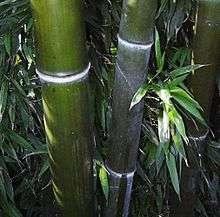Phyllostachys
| Phyllostachys | |
|---|---|
 | |
| Phyllostachys nigra | |
| Scientific classification | |
| Kingdom: | Plantae |
| (unranked): | Angiosperms |
| (unranked): | Monocots |
| (unranked): | Commelinids |
| Order: | Poales |
| Family: | Poaceae |
| Subfamily: | Bambusoideae |
| Tribe: | Arundinarieae |
| Genus: | Phyllostachys Siebold & Zucc. |
| Synonyms[1] | |
|
Sinoarundinaria Ohwi | |
Phyllostachys (/ˌfɪloʊˈstækᵻs, -lə-, -ˈsteɪ-/[2][3]) is a genus of Asian bamboo in the grass family.[4][5][6] Many of the species are found in Central and southern China, with a few species in northern Indochina and in the Himalayas. Some of the species have become naturalized in parts of Asia, Australia, the Americas, and southern Europe.[7]
The stem or culm has a prominent groove, called a sulcus, that runs along the length of each segment (or internode). Because of this it is one of the most easily identifiable genera of bamboo. Most of the species spread aggressively by underground rhizomes.[7]
Some species of Phyllostachys grow to 100 feet (30 m) tall in optimum conditions. Some of the larger species, sometimes known as "timber bamboo", are used as construction timber and for making furniture.[7]
The name Phyllostachys means "leaf spike" and refers to the inflorescences.[8]
Some of the smaller species can be grown as bonsai.
- Species[9]
- Phyllostachys acuta
- Phyllostachys angusta
- Phyllostachys arcana
- Phyllostachys atrovaginata
- Phyllostachys aurea
- Phyllostachys aureosulcata
- Phyllostachys bambusoides
- Phyllostachys bissetii
- Phyllostachys carnea
- Phyllostachys circumpilis
- Phyllostachys dulcis
- Phyllostachys edulis
- Phyllostachys elegans
- Phyllostachys fimbriligula
- Phyllostachys flexuosa
- Phyllostachys glabrata
- Phyllostachys glauca
- Phyllostachys guizhouensis
- Phyllostachys heteroclada
- Phyllostachys incarnata
- Phyllostachys iridescens
- Phyllostachys kwangsiensis
- Phyllostachys lofushanensis
- Phyllostachys mannii
- Phyllostachys meyeri
- Phyllostachys nidularia
- Phyllostachys nigella
- Phyllostachys nigra
- Phyllostachys nuda
- Phyllostachys parvifolia
- Phyllostachys platyglossa
- Phyllostachys prominens
- Phyllostachys propinqua
- Phyllostachys rivalis
- Phyllostachys robustiramea
- Phyllostachys rubicunda
- Phyllostachys rubromarginata
- Phyllostachys rutila
- Phyllostachys shuchengensis
- Phyllostachys stimulosa
- Phyllostachys sulphurea
- Phyllostachys tianmuensis
- Phyllostachys varioauriculata
- Phyllostachys veitchiana
- Phyllostachys verrucosa
- Phyllostachys violascens
- Phyllostachys virella
- Phyllostachys viridiglaucescens
- Phyllostachys vivax
- formerly included[1]
species now considered better suited to other genera: Bambusa Chimonobambusa Pseudosasa Semiarundinaria Shibataea
- Phyllostachys fastuosa - Semiarundinaria fastuosa
- Phyllostachys kumasasa - Shibataea kumasasa
- Phyllostachys marmorea - Chimonobambusa marmorea
- Phyllostachys maudiae - Pseudosasa hindsii
- Phyllostachys mitis - Bambusa vulgaris
- Phyllostachys quadrangularis - Chimonobambusa quadrangularis
- Phyllostachys ruscifolia - Shibataea kumasasa
Ecology
Fungi and pathogens growing specifically on Phyllostachys have phyllostachydis or phyllostachydicola species epithets.
Regulations
Connecticut property owners are liable for the cost of removing Phyllostachys bamboo that grows onto neighboring property, any resulting damages, and fines of $100 per day for growing Phyllostachys bamboo near an adjoining property or public way without an effective barrier system. [10]
New York state has proposed regulations listing Phyllostachys aurea and Phyllostachys aureosulcata as prohibited invasive species. [11] [12]
References
- 1 2 Kew World Checklist of Selected Plant Families
- ↑ "Pronunciation Guide for Plants". Retrieved 2016-01-22.
- ↑ "Pronunciation of phyllostachys". Retrieved 2016-01-22.
- ↑ Siebold, Philipp Franz Balthasar von, & Zuccarini, Joseph Gerhard. 1843. Abhandlungen der Mathematisch-Physikalischen Classe der Königlich Bayerischen Akademie der Wissenschaften 3(3): 745-749 descriptions in Latin, commentary in German
- ↑ Siebold, Philipp Franz Balthasar von, & Zuccarini, Joseph Gerhard. 1843. Abhandlungen der Mathematisch-Physikalischen Classe der Königlich Bayerischen Akademie der Wissenschaften 3(3): plate V (5), figure III (3) at lower right line drawings of Phyllostachys bambusoides
- ↑ Tropicos, Phyllostachys Siebold & Zucc.
- 1 2 3 Flora of China Vol. 22 Page 163 刚竹属 gang zhu shu Phyllostachys Siebold & Zuccarini, Abh. Math.-Phys. Cl. Königl. Bayer. Akad. Wiss. 3: 745. 1843.
- ↑ Coombes, Allen J. (2012). The A to Z of plant names. USA: Timber Press. p. 312. ISBN 978-1-60469-196-2.
- ↑ The Plant List search for Phyllostachys
- ↑ "Connecticut General Statutes Title 22a Chapter 446i Section 22a-381e". Retrieved 2014-05-06.
- ↑ "Lands and Forests Emergency, Proposed & Recently Adopted Regulations". Retrieved 2014-05-06.
- ↑ "Proposed Regulations : 6 NYCRR Part 575 Prohibited and Regulated Invasive Species Express Terms". Retrieved 2014-05-06.
- Zheng-ping Wang & Chris Stapleton Flora of China, Volume 22: Poaceae., Science Press u. a., Beijing u. a. 20
External links
- "Phyllostachys Siebold & Zucc.". Tropicos.org. Missouri Botanical Garden. Retrieved 2012-07-30.
- http://delta-intkey.com/grass/www/phyllost.htm
![]() Media related to Phyllostachys at Wikimedia Commons
Media related to Phyllostachys at Wikimedia Commons
| Wikispecies has information related to: Phyllostachys |